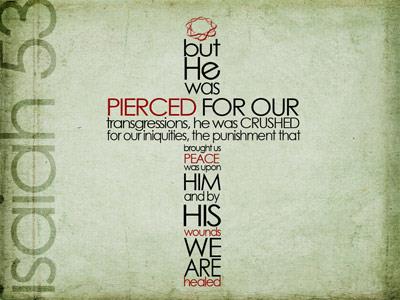-
"So Great A Salvation. So Perfect A Sacrifice."
Contributed by Quintin Morrow on Nov 28, 2017 (message contributor)
Summary: A message on the sufficiency of the atoning death of Jesus Christ on the cross.
"So Great a Salvation. So Perfect a Sacrifice"
Hebrews 10:1-25
The Rev’d Quintin Morrow
Preached at St. Andrew’s Episcopal Church, Fort Worth
March 17, 2002
In the waning decades of the first century before the of birth Christ a Roman poet and dramatist named Quintus Horatius Flaccus wrote to give the young playwrights of his day some much needed advice. Plays in Horace’s day were convoluted and confusing affairs, with several complicated and sometimes contradictory plots, themes and characters. It was customary, in the last act of the play, when it was impossible to reconcile all of the tangled characters, plots and circumstances, for Horace¡¦s con-temporaries to simply write in the appearance of one or more of the gods--Apollo, Zeus, Mars--to magically wrap up all the loose ends before the final curtain fell. Horace himself thought this a rather predictable and anti-climactic practice. His advice to young playwrights was this:
Do not put a god on stage, unless the problem is one that deserves a god to solve it.
Hebrews chapter 10 describes just that: How the one, true and living God intervened--stepped on stage--to solve the problems of sin and judgment that only He could solve.
The author of Hebrews is writing this letter--which in structure and argument more closely resembles a sermon than a letter--to a local church of second generation Jewish Christians wavering in their commitment to Christ and contemplating aban- doning the Christian faith and returning to Judaism. The tone of the book is one of persuasion and admonition; and the theme of the Hebrews is the superiority of the person, offices and work of Jesus Christ--His superiority over the Mosaic Law, the Levitical priesthood, angels, temples, old covenant sacrifices, and sin.
Like any good letter seeking to persuade, or, like any good sermon, for that matter, Hebrews builds a logical, sequential argument in which each successive point is built upon the one before. In Hebrews chapters 8 and 9 the author demonstrates that Jesus Christ’s eternal high priesthood is superior to and in fact supercedes the Aaronic high priesthood of the Old Testament, and that the New Covenant initiated in His blood on the cross is superior to the Old Covenant initiated at Mt. Sinai with the blood of bulls and goats.
Chapter 10 of Hebrews builds on the arguments of its preceding chapters and demonstrates that Jesus Christ’s once-for-all, substitutionary death upon the cross was the perfect payment for the sins of the whole world; therefore, the animal sacrifices of the Old Testament--being imperfect--have been rendered obsolete. The author rests his case in the last 7 verses of our passage, Hebrews 10:1-25, with an appeal for members of the New Covenant to enjoy and exercise the privileges, as well as live up to the responsibilities, of what Christ’s death has won for us.
Chapter 10 begins, first of all, with a declaration of the utter insufficiency of the Old Testament sacrificial system to permanently rectify the breach in the relationship between God and man caused by human sin. In verses 1 through 9 the author of Hebrews describes the inadequacy of the animal sacrifices of the Levitcal system, with evidence from the sacrificial system itself and Scripture, and he holds up the prospect of a better sacrifice; that sacrifice was the voluntary death of Jesus Christ that atoned once-for-all for the sins of the world.
You must know that the Old Testament sacrificial system was instituted by God. It was grace. It provided the means for God’s people, in holy covenant with Him, to span the breach caused by sin. An animal, representing the worshipper, who had violated the law of God, would be brought to the Tabernacle or Temple, sacrificed and consumed by fire. Thus, the sin-debt was paid vicariously by the death of a substitute, and the worshipper was restored to his rightful place of privilege as heir of covenant membership. But this system of ritual animal sacrifice was never meant to be permanent, and it never was able to remedy the real problem: a human heart corrupted by sin. Listen:
1For since the law has but a shadow of the good things to come instead of the true form of these realities, it can never, by the same sacrifices which are continually offered year after year, make perfect those who draw near. 2Otherwise, would they not have ceased to be offered? If the worshipers had once been cleansed, they would no longer have any consciousness of sin. 3But in these sacrifices there is a reminder of sin year after year. 4For it is impossible that the blood of bulls and goats should take away sins (Heb. 10:1-4).
Bibles scholars tell us that on Yom Kippur, the Old Testament Day of Atonement, in excess of 100,000 animals were likely slaughtered in the Temple precincts. The blood would be collected by the priests and splashed against the base of the altar. The carcass of the sheep or bull or goat would be cleaned, carved up and burnt on the altar. The blood of so many animals would run in streams through specially-built gutters flowing outside of the city of Jerusalem and empty into a brook called Kidron, and turn it crimson. Imagine the sights, the smells, and the sounds of that day. The Temple became a slaughterhouse. But it wasn’t enough. It wasn’t enough to permanently fix our sin problem and restore us to intimate relationship with our creator.

 Sermon Central
Sermon Central



